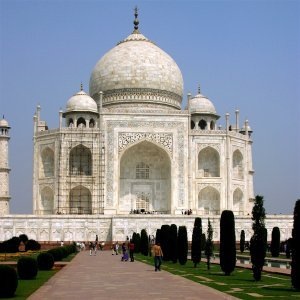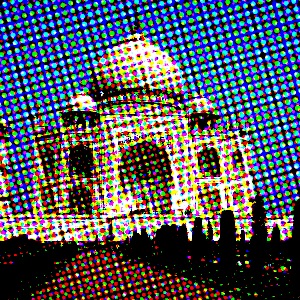| 5.8. Foto de diari | ||
|---|---|---|

|
5. Filtres de distorsions |  |
Figura 17.72. Exemple d'aplicació del filtre Foto de diari

Imatge original

Filtre «Foto de diari» aplicat mitjançant el mode color RGB, patró Quadrat per a tots els canals, període vermell 6, període verd 8, període blau 10, angle 15 per a tots els canals.
Aquest filtre realitza tramatges digitals amb modulacions opcionals. El tramatge és el procés de renderització d'una imatge amb diversos nivells de gris o color (és a dir, una imatge de to continu) en un dispositiu amb menys tons; sovint un dispositiu de dos nivells com ara una impressora. Tingueu en compte que Foto de diari no és un filtre per generar pantalles de mitjos tons per a la impressió, sinó per simular l'aparença d'imprimir-hi.
El principi bàsic és sacrificar la resolució per una més gran profunditat de color (això es coneix com a tramatge espacial).
Diversos enfocaments són possibles, el més senzill és ignorar els bits de menys pes de la informació tonal; és el que fa el filtre Posteritza. Malauradament, els resultats no semblen gaire bons. Tanmateix, no es perd resolució espacial.
Imagineu una quadrícula superposada a la imatge original. La quadrícula divideix la imatge en cel·les, cada cel·la mantindrà en última instància un únic punt format per múltiples píxels de sortida per tal d'aproximar la foscor de la imatge original en aquesta cel·la. Òbviament, una gran cel·la grossa provoca una gran pèrdua de resolució!
![[Nota]](images/note.png)
|
Nota |
|---|---|
|
Aquestes opcions es descriuen a Secció 2, «Característiques comunes». |
Aquest grup controla els canals per utilitzar, i la configuració de cada canal.
Seleccioneu les tintes de color que voleu utilitzar: Blanc sobre negre, Negre sobre blanc, RGB o CMYK.
Ací s'enumeren els paràmetres que es poden canviar per a cada tinta de color o canal.
Seleccioneu el patró de tramatge que voleu utilitzar. Les opcions són Línia, Cercle, Diamant,, Quadrat, Línies creuades.
El nombre de píxels en una repetició d'un patró base amb resolució base.
L'angle de la quadrícula que s'ha d'utilitzar. Aquest angle es pot ajustar amb el lliscador, l'entrada de números, o amb el control de l'angle movent la fletxa en el cercle.
Aquesta configuració només està disponible quan s'ha escollit CMYK com a model de color i el canal seleccionat és Negre. Regula la quantitat de gris comú per treure de CMY.
Aquestes tres caselles de verificació, si estan activades, bloquegen la configuració esmentada anteriorment perquè sigui la mateixa per a tots els canals. Si estan desactivades, llavors aquests paràmetres es poden configurar individualment per a cada canal.
Factor de sobremostratge d'antialiàsing Això estableix el nombre de mostres de mitjana per a suavitzar el resultat.
Els tramatges adequats no necessiten antialiàsing: al capdavall, l'objectiu és reduir la profunditat del color. No obstant això, com que aquest connector és principalment per a efectes especials, els resultats es mostren a la pantalla en lloc d'una impressora. Per tant, sovint és útil aplicar una mica d'antialiàsing per simular taques de tinta sobre el paper. Si voleu imprimir la imatge resultant, configureu l'antialiàsing a 1 (és a dir, desactivat).
Saturació del color depenent de la compressió del període.
Nombre de períodes per tessel·la. Aquest mosaic evita les anomalies d'alta freqüència que provoca l'augment de l'angle.
Factor de multiplicació per al gir desitjat de l'espai local per a la textura. La manera com es calcula afebleix els colors desaturats i segurament enforteix on hi ha color.